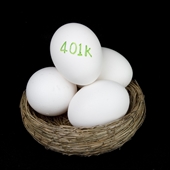 If you’ve ever found yourself tempted to stop investing when the market was declining, you now have one more piece of evidence that it’s best to stick with your game plan through good and bad market conditions.
If you’ve ever found yourself tempted to stop investing when the market was declining, you now have one more piece of evidence that it’s best to stick with your game plan through good and bad market conditions.
A recent study analyzed 7.5 million 401(k) plan participants who participated in their plans consistently throughout 2007-2012 and compared their results with the broader database of 24 million participants. The broader database also includes those who had enrolled in or dropped out of their plans during that time frame. Despite the stock market drop of 2008, the average account balance of 401(k) participants who continued investing during the five-year period ending December 31, 2012, grew by a compound average annual rate of 6.8%, according to the study. The average account balances of the broader database actually declined by 0.5%.
This data strikingly supports the value of a consistent investment program. During a market decline, many investors become scared and stop making their contributions for fear of “throwing good money after bad.” This mistake is costly, however, because during a downturn consistent investors can actually purchase more shares for the same of money because the prices are lower.
The study called “What Does Consistent Participation in 401(k) Plans Generate? Changes in 401(k) Account Balances, 2007-2012,” was conducted by the Employee Benefit Research Institute (EBRI) and the Investment Company Institute (ICI) in July this year. There are also some other interesting take-aways:
- Over the analyzed period, the average account balance for consistent participants grew from $77,049 at the end of 2007 to $107,053 at year-end 2012; this was significantly higher than the 2012 average balance of the broader group ($63,929).
- The median account balance for consistent participants at the end of 2012 was $49,814, almost three times higher than the median balance of the larger group ($17,630).
- As of December 31, 2012, over 30% of the consistent participants had more than $100,000 in their 401(k) accounts, compared with just 18% of the broader group.
Investing requires patience, discipline, and consistency. This study is just one more example that maintaining a consistent focus over the long term is hugely important to a successful investment outcome and being prepared for retirement.
Target Date Fund Usage On the Rise
In addition to the above findings, the study also focused on the use of target date funds. The share of consistent participants who included target-date funds in their portfolios rose from 27.6% to 32.1% between year-end 2007 and year-end 2012. While all age groups experienced slight increases in the usage of target-date funds, those in their 40s and 50s saw the largest boost.
Among the entire EBRI/ICI database, the use of target-date funds rose substantially, from 25.1% at year-end 2007 to 41% by year-end 2012. The study’s authors surmised that the rise was due in part to the increase in auto-enrollment and the use of target-date funds as the default investment, as well as the overall boost in plans offering target-date funds as an option.
In a target-date fund, the target date is the approximate date upon which an investor plans to withdraw money. The mix of investments in the target-date fund becomes conservative as the date grows closer.
Target date funds can be a great choice when you’re just starting out with investing. Sometimes, they also offer a lower cost option than picking individual asset class funds in your employer retirement plan. As financial advisors, we review the target date funds and individual asset class funds to determine the best option in the plan for a particular financial planning client’s situation. We then give a recommendation on what funds and percentages to use to achieve their target asset allocation efficiently.